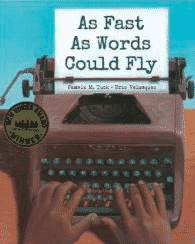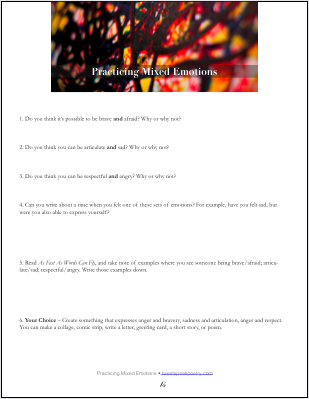Doing math happened like this: My dad and I sat together at the dining room table. He had two or three mechanical pencils; a thick, white eraser; and a tablet of graph paper. I had my loose leaf notebook paper that was mostly shredded from all my blotted attempts, a dull pencil with an eraser scraped to the metal, and several Kleenex scattered around my pre-algebra textbook.
“When am I ever going to need this?” I sobbed.
My dad, the most patient man in the world, slowly showed me again how to solve for x, neatly filling the boxes of graph paper. He knew he didn’t have an answer that would satisfy me. If he’d told me, “Algebra teaches you how to think,” I would’ve said, “I think this is bullsh—t,” and I would’ve been sent to bed.
I never had this angst about writing. I can endure confusion, uncertainty, sadness, and anger in stories whether it’s one I’m reading or writing. However, I know students who’ve desperately asked the same question I asked about math: When will I ever need this?
On the day the new U.S. president was chosen, I was teaching in Detroit. I knew my students wanted to talk about the election, and I also knew I didn’t want my classroom to turn into a screaming free-for-all. So I brought in a story.
Teaching Mixed Emotions Through the Story
As Fast As Words Could Fly, by Pamela M. Tuck, is a nonfiction picture book about a boy named Mason Steele. Mason was a writer who, as a young boy, turned “his father’s excited ramblings about the latest civil rights incidents into handwritten letters.” Mason was also a self-taught typist, and one of the first black children (along with his brothers) in Greenville, North Carolina, to attend a previously segregated all-white school.
Before I read the book to my students, I asked: Can you be brave and afraid, articulate and sad, respectful and angry at the same time?
As we read, we looked for examples of where the Steele family, as well as some of the white characters, were both of these things at once. Here we have one of the many examples of the power of story: it loosens up knots we’ve tied within ourselves. It shows us possibility in people we might otherwise write off.
After we discussed the story, I asked students to write a letter to the then President-elect, keeping these questions in mind. I told them it is absolutely okay and perhaps necessary to be afraid and sad and angry, but we must figure out a way to express these emotions so we open up possibilities and loosen tight knots. I suggested exploring how Mason Steele did it, and we took a look at the story again. We studied facial expressions and body language from the pictures. We analyzed the words characters spoke. I also suggested they find a story to tell the new president. “Tell him about yourself; something you’ve done, something you’d like to do with your life.”
One sixth grader told him how much she loves gymnastics; another told him she thinks she wants to be a writer, but she’s nervous about the work. Another boy wrote about a time he was walking home from school and found a kitten lying in the gutter. “I took him home and gave him milk, and I think what I did was good.”
Picture books are excellent for all ages and if you have smaller children at home or school, it’s possible to teach the same concept of “mixed emotions” on a simpler level. Look at the pictures, discuss and define “civil rights.” Ask students if they’ve ever been in a situation when it was hard to speak because they were angry or afraid. Children can draw cartoon strips, or collages expressing a time (or times) when this has happened. Instead of a letter, consider making a greeting card for a government official thanking them for their work, but also expressing a concern.
The point is to get students practicing a skill when they might be discouraged and might not see the point of pursuing that skill. In As Fast As Words Can Fly, students can walk with Mason Steele and watch him feel tough, conflicting emotions (and maybe feel them along with him), and they can see Mason continue to put one foot in front of the other.
I never became a master at math. Thinking about solving equations makes me short of breath, but maybe what my dad was trying to show me was not so much how to solve for x; but how to struggle with x. Through the power of story, we can teach students the art of doing the same—whatever x might be.
Photo by Siris, Creative Commons, via Flickr. Post by Callie Feyen.
“Practicing Mixed Emotions” Activities & Discussion
1. Do you think it’s possible to be brave and afraid? Why or why not?
2. Do you think you can be articulate and sad? Why or why not?
3. Do you think you can be respectful and angry? Why or why not?
4. Can you write about a time when you felt one of these sets of emotions? For example, have you felt sad, but were you also able to express yourself?
5. Read As Fast As Words Can Fly, and take note of examples where you see someone being brave/afraid; articulate/sad; respectful/angry. Write those examples down.
6. Your Choice – Create something that expresses anger and bravery, sadness and articulation, anger and respect. You can make a collage, comic strip, write a letter, greeting card, a short story, or poem.
__________________________

“This will be the main textbook for the poetry unit from now on.”
—Tom Hunley
- Poetry Prompt: Courage to Follow - July 24, 2023
- Poetry Prompt: Being a Pilgrim and a Martha Stewart Homemaker - July 10, 2023
- Poetry Prompt: Monarch Butterfly’s Wildflower - June 19, 2023



L.L. Barkat says
Somehow this reminds me of a meditation practice called tonglen, in which you work with both sides of an issue by breathing in the hard emotions and breathing out relief and relaxation. It’s a way to suspend both in yourself simultaneously and therefore train in empathy, compassion, and steadiness.
I like the idea that there are multiple ways to do such a thing—story being one. We take the story in, and we come out with increased empathy and compassion. Thanks for sharing this particular story with us. I’m going to order it from my library right now! 🙂
Donna Falcone says
LL I like what you said about tonglen – a wonderful practice.
It’s so important to find ways to work with our emotions, and not allow them to work on (have ultimate control) over us, like you did Callie, with your students. It seems you were helping them see there are different ways to “be with” mixed emotions with Grace.
This is the thing, isn’t it…. ? Grace. Teaching children to give themselves Grace can bring them ease within, and they grow they may be more likely to offer Grace to others. Training ourselves, and helping children to learn, empathy and compassion can ONLY come from the conflicted and difficult times. It can be so confusing, and that’s fine. It’s okay to feel confused – that’s how you know there is something in need of tending to. 😉
I think art, most recently, has done this for me. Over time, the expressive arts have all played a role in my life of helping me through the conflicting times… much of the time I wasn’t even aware of it.
Callie Feyen says
“It’s okay to feel confused – that’s how you know there is something in need of tending to.” What a GRACEful sentence. I think it’s a game changer for me – there is so much today that I am confused with. Instead of getting frustrated, perhaps it’s time to be OK with the confusion and tend to it…with grace.
Donna Falcone says
🙂
Callie Feyen says
“Working with both sides of an issue.” I like that. I find it easiest to do while reading or listening to a story, but breathing would be a nice addition to my practice. 🙂
What I especially love about this story is it is Creative Nonfiction. So I can say to my children or my students, “This is true, and if Mason can walk with mixed emotions, so can you.”That’s the trick, I suppose. Fear and sadness and anger are there, but that’s not all that’s there. Breathe deeply and look around.
Bethany R. says
“Struggling with x.” What a great post, and what a fitting image for it: “a dull pencil with an eraser scraped to the metal”
The questions you pose to your class are extremely helpful. “Can you be brave and afraid, articulate and sad, respectful and angry at the same time?” This will be a great dinner conversation starter with my family. Just considering the idea of being simultaneously angry and respectful shifts possibilities in a productive way. Interesting meditation practice L.L. brings up in relation to this!
For me, the idea of being articulate and sad seems most doable in writing (when I’m sad I don’t usually have the oomph for conversation). My go-to is journaling, but I like this application of writing letters or making cards for people in positions of influence. Thanks for this lesson, Callie.
Donna Falcone says
Journaling has always been so helpful for me, too, Bethany.
I love the idea of writing letters and cards to people in position as well… it humanizes them, and it helps us validate ourselves. 🙂
Callie Feyen says
Thank you, Bethany.
Throughout the book, I found it helpful for me to watch the face of Mason Steele as I read the story because I would get so angry and so sad. He was treated so badly, and he kept working away (and he won this great big typing contest with an old typewriter when everyone had these brand new shiny ones). It’s a powerful lesson for me, as well as my students and children.
Also, I’m with you – I can write the sad/anger/fear better than I can speak it. I must see these things on paper first…make them my friends. 🙂
Bethany R. says
Callie, do you mind if I ask what grade(s) you were teaching in this piece? I think it’s wonderful how they responded to the story and questions you posed.
Bethany says
I see that the piece mentions a sixth grader, so that probably answers my question, but wondered if maybe you had a sixth-seventh combo?
Callie Feyen says
Hi Bethany! This was a group of sixth graders, but I actually did a similar lesson with Kindergarten-2nd graders as well. While they didn’t write as much, and their answers were different than 6th graders, they were still able to understand this idea of feeling/being two different things at the same time. They were also able to point out these things from the looking at the pictures of the characters’ facial expression, whereas for the 6th graders, I had to point it out. I think this gets at how emerging readers learn vs more fluent readers learn, and sadly, something gets lost when we stop using picture books in the classroom of older students. However, I see I am beginning to go on a tangent, so maybe that’s a story for another day. 🙂 At any rate, this one was with 6th graders, but I have found success with the littler kiddos, too. 🙂 Hope this helps!
Bethany says
Thanks so much for this, Callie. 🙂 So cool to hear about your time with the K-2 kids as well as the 6th graders. What an interesting point about reading and storybooks at different ages. 🙂
John Thomas says
Great comments and message, Bethany! I will think about this! – JT in Staten Island, New York (New York City) USA
Bethany R. says
Hi Dad, This wonderful article was actually written by (the fabulous) Callie Feyen. But I wrote a post that was inspired by it. Let’s see if I can post the link here: https://www.tweetspeakpoetry.com/2017/06/01/literacy-conversation-advice-for-parents/ 😀
Donna Falcone says
I am SO glad you wrote this. Mixed emotions are difficult, not only for some young children, older children, and adolescents, but some full grown adults as well. One of my sons is pretty accepting of the opposites- it doesn’t shake him. My other son adds distress on top of distress when he realizes he is feeling mixed, or even opposite, emotions at the same time. This is a book I wish I’d had when he was younger – maybe his adolescence would have been easier. Thank you, Callie. Your students in Detroit are so lucky to have you.
Callie Feyen says
Mixed emotions are truly difficult, aren’t they? At least for me, I find every day is one filled with mixed emotions. I’m thankful for stories that show me other people walking around feeling afraid and brave at the some time. 🙂
Thank you for your kinds words, Donna.
Megan Willome says
Callie, this is so wonderful! I love nonfiction picture books–they really distill a story while adding that key visual element. I have one I’m going to point to in my current TSP workshop.
I like your sentence in the comments,” I must see these things on paper first…make them my friends.” That often helps me too. Although I am getting better at not being bothered by feeling opposite things at the same time, it can be hard for me to express them simultaneously.
Thank heavens for teachers like you!
Callie Feyen says
Thank you, Megan. Yes, I am with you: I feel ok feeling opposites, but it is expressing them that is tricky. That’s usually when I know I have something to write about, though. 🙂
Which picture book are you using for your course?
Marilyn Yocum says
Expand, if you will, on the justapositioning* of “articulate” and “sad.” Are they set as seeming (but not real) opposites because when we are sad, we tend to clam up? Many writers claim a bit of paralysis when they hit the hard emotions, almost as though there was a shame attached to expressing negative feelings. For many, that was the case, and as the result we grow to be adults without proper, necessary tools. Is that what you mean?
This is a wonderful post with excellent discussion questions.
*probably made-up word, sorry
Callie says
Hi Marilyn,
Thanks for the question, and for your kind words on this post. I appreciate them both.
I think you are exactly right: writers, speakers, and just people in general tend to clam up because the thought of expressing those harder emotions is overwhelming. But I have found, and what I try to teach to my students, is that yes, sadness is prevalent, but when we put it on the page, is that all that’s there? Sometimes, sure, but I wonder if in the act of creating something out of that sadness (a poem, a letter, an essay, a speech, a short story), something is soothed. I wonder if creating itself is a balm for those harder emotions. Does it take them away? Not necessarily, but I think the act of creating something from our sadness (or fear, or anger) is good for our souls.
The day I asked my students if they could be sad and articulate, they came into my classroom, hurt, angry, and very, very raw. I thought that it was important to acknowledge this, to hear them in all their anger and sadness, but I believe it was equally important to help them express. That is, articulate it. That’s why I asked them that question, and that’s why I read As Fast As Words Can Fly. In it, they saw real people being both afraid and brave, angry and respectful, and sad and articulate.
I don’t know if this answers your question. I’d be happy to try again, though. 🙂